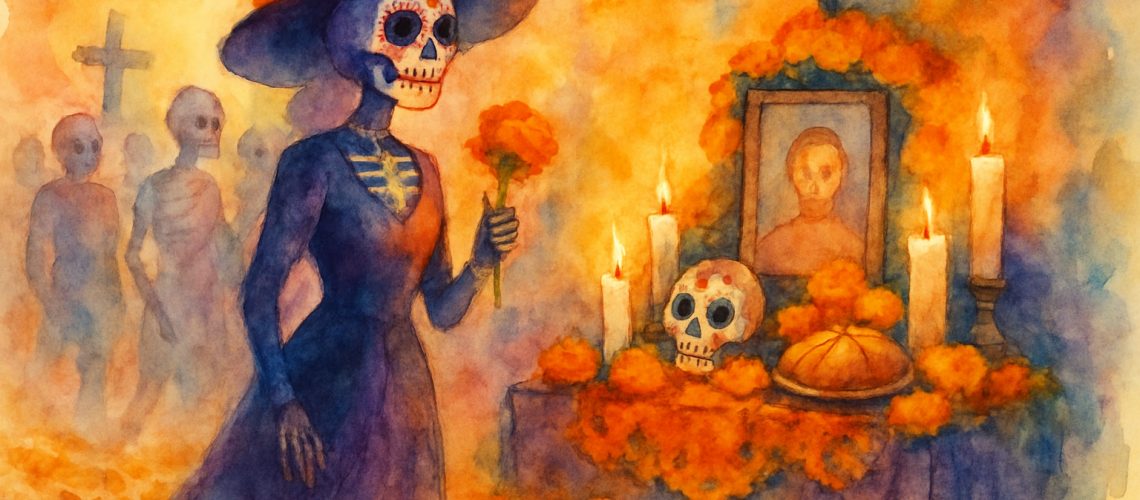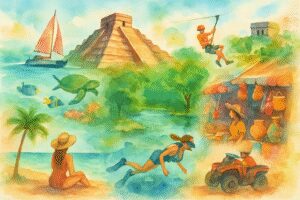Discovering Cancun’s Unique Day of the Dead Traditions
In the heart of Mexico, Cancun transforms during the Day of the Dead celebrations, presenting an extraordinary fusion of ancient Mayan customs and vibrant Mexican heritage. This annual festival, known locally as Hanal Pixan – a term that translates to the nourishing food of souls in the Mayan language – offers a deep, spiritual journey intertwined with colorful rituals and heartfelt remembrances.
The celebration spans from the end of October until early November, inviting families and communities to engage in a series of events that honor those who have passed on. Imagine winding streets adorned with incense and marigold flowers, lively processions of elegantly dressed skeletal figures, and public spaces turned into breathtaking art galleries where altars tell the stories of bygone eras. The fusion of traditions creates an atmosphere that is both solemn and exuberantly festive.
An Immersive Look at the Festival’s Schedule and Key Moments
The festivities begin on October 29 and extend until November 2. During these days, every moment is filled with symbolic acts that bridge the realms of the living and the departed. Central to the celebration is the procession of finely attired skeletal figures, which takes place on October 30. This unique parade symbolizes an elegant tribute to death, where each step unfolds like a story, reminding participants of the beauty and impermanence of life.
But the event is far more than just a parade. It is also a showcase of meticulously crafted altars and offerings that are arranged in public squares such as the Plaza of Palapas. These sites are transformed into sanctuaries of memory, where photographs of loved ones, sacred relics, and an array of symbolic elements are carefully displayed. The altars serve as a beacon, guiding the souls back home and offering the living a moment of reflection.
Experiencing the Cultural Extravaganza Beyond the Processions
Beyond the striking processions and elaborate altars, Cancun’s Day of the Dead celebrations are rich with diverse cultural activities. Local artisans display their crafts, theaters host dramatic interpretations of myth and history, and musicians fill the air with sounds that evoke both longing and joy. Visitors can expect to experience live performances, interactive exhibitions, and intimate gatherings that echo the sentiments of love and remembrance.
A particularly moving tradition during the festival is the visitation of cemeteries. Families and friends come together to decorate graves with bright marigold flowers, candles that symbolize purity and mourning, and even the favorite foods and beverages of the departed. These gestures not only pay homage to those who have left but also reinforce the belief that celebrating their lives is the highest form of respect.
Unveiling the Elements of the Altars
At the core of the celebrations are the altars – spaces entirely devoted to the honored memories of family and friends. Each altar is a blend of personal mementos and time-honored symbols. Photographs of departed loved ones, sacred items such as crosses or saint images, and vibrant marigold flowers that are believed to lead the souls to their final destination collectively construct a narrative of love and continuous presence.
Complementing the imagery are candles that bathe the space in a gentle glow, and food offerings such as Pan de Muertos along with sugar skulls that add a touch of tradition and sweetness to the ritual. Every item on the altar is chosen deliberately to evoke memories, stir emotions, and set the stage for a cherished reunion between the spiritual and the tangible.
Celebrating Life Through the Lens of Tradition
The essence of Hanal Pixan lies in its profound celebration of life itself. Rather than mourning a loss, this festival encourages a joyous recollection of the past. It is a time when communities come together not in sorrow, but in heartfelt gratitude and love. The vibrant hues, flavorful foods, and spirited music contribute to an ambiance where every ritual signifies hope, renewal, and an unbreakable familial bond.
Each ritual is laden with significance – from guiding the souls with the light of candles to narrating the stories of ancestors through art, every element reinforces a cultural narrative that transcends time. The festival, steeped in tradition yet brimming with contemporary vibrancy, ensures that while the departed are celebrated, the living are constantly reminded of their roots and the importance of carrying forward these legacies.
Conclusion: A Journey Beyond the Ordinary
The Day of the Dead celebrations in Cancun stand as a testament to the enduring spirit of life, the eternal nature of memory, and the power of cultural unity. Every ritual, procession, and altar is a page in a living storybook that invites people to relive cherished moments while looking forward to new beginnings. By diving into these traditions, both locals and visitors are offered a unique opportunity to experience a celebration that is as emotionally deep as it is visually stunning.
Are you ready to embark on this journey of remembrance and festive vibrancy? Explore the traditions, savor the atmosphere, and let the legacy of Hanal Pixan inspire you to appreciate the beauty of life and the art of remembrance.
Summary
The Day of the Dead celebration in Cancun offers a mesmerizing blend of ancient Mayan customs and rich Mexican heritage, inviting participants to honor the memory of departed loved ones in a unique and vibrant setting. This festival, observed from October 29 to November 2, is a powerful call to celebrate life rather than mourn its absence. It features dynamic processions of elegantly attired skeletal figures, immersive cultural events including art exhibitions, theatrical performances, and bustling craft markets that engage locals and tourists alike. At its heart are intricately designed altars adorned with photographs, religious icons, marigold flowers, candles, and traditional foods that embody love, remembrance, and spiritual guidance. Using symbols that guide the souls back home, the city celebrates with joy, music, and colors that speak of both loss and renewal. This experience is crafted to captivate your attention, spark a deep interest in cultural traditions, foster a desire to explore these vibrant rituals further, and call you to action to immerse yourself in a celebration that transforms the ordinary into an unforgettable tribute of life.
Frequently Asked Questions about Cancun's Day of the Dead Traditions
What is the significance of Hanal Pixan in Cancun?
Hanal Pixan is a cherished tradition that translates to the nourishing food of souls in the Mayan language. It acts as a symbolic bridge between the living and the departed, reinforcing community ties and cultural identity.
When do the Day of the Dead celebrations take place in Cancun?
The festivities begin on October 29 and conclude on November 2, featuring a variety of events that span processions, altar displays, and cultural activities.
What are the main elements featured on the altars?
Altars typically display photographs of lost loved ones, religious symbols, marigold flowers that guide the souls, glowing candles, traditional Pan de Muertos, and sugar skulls – all arranged to evoke memories and honor the departed.
How do processions contribute to the celebration?
The processions, characterized by elegantly dressed skeletal figures, serve as a moving tribute to death, emphasizing the beauty and continuity of life through symbolic storytelling.
Are the cemetery visits part of the festivities?
Yes, visiting cemeteries to decorate graves with flowers, candles, and food offerings is a significant ritual that reinforces the bond with ancestors and celebrates their enduring presence.
Why is the celebration considered a tribute to life?
The festivities are designed not only to remember the departed but also to celebrate life with music, art, and communal gatherings, reminding everyone of the beauty and continuity of existence.













